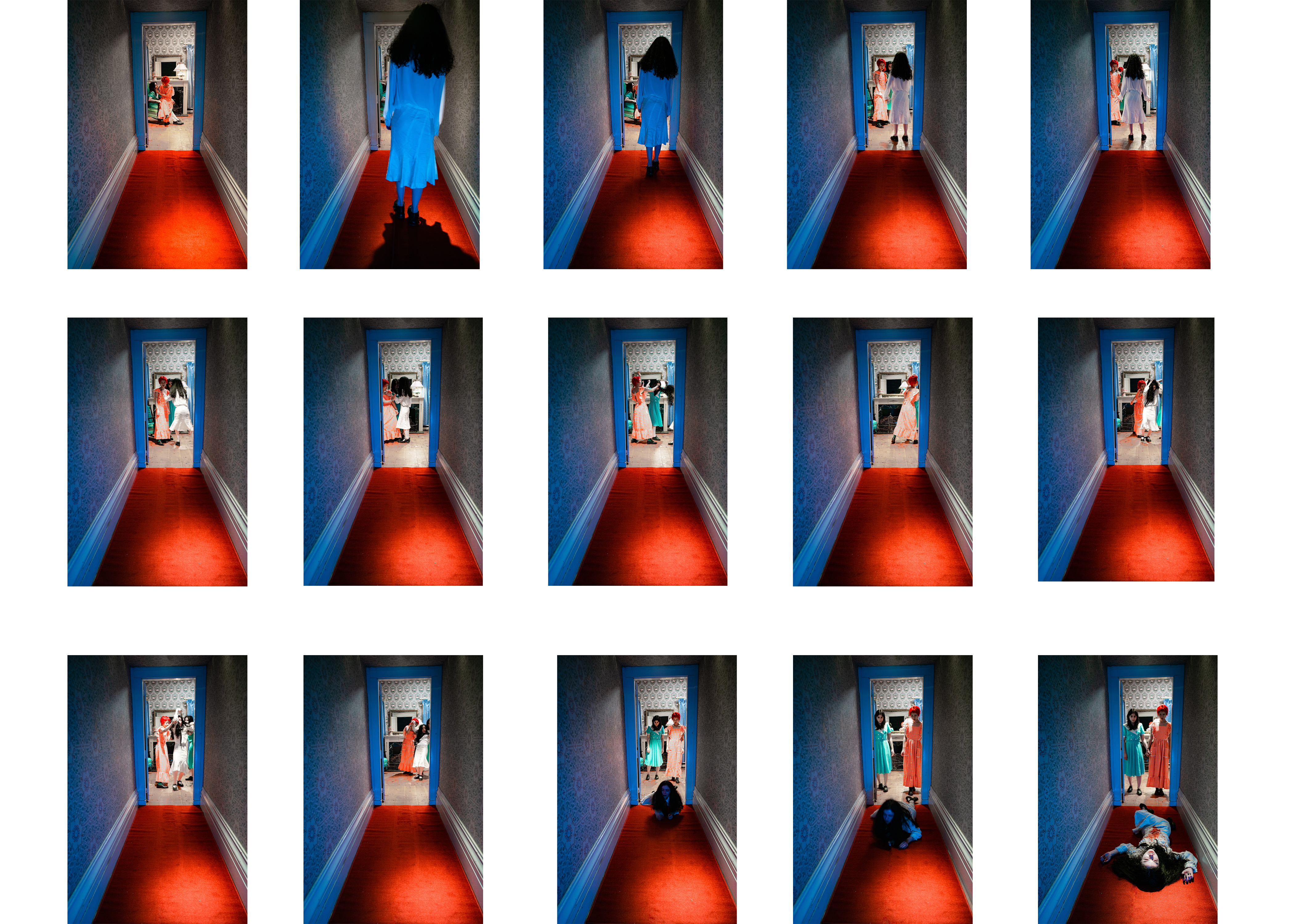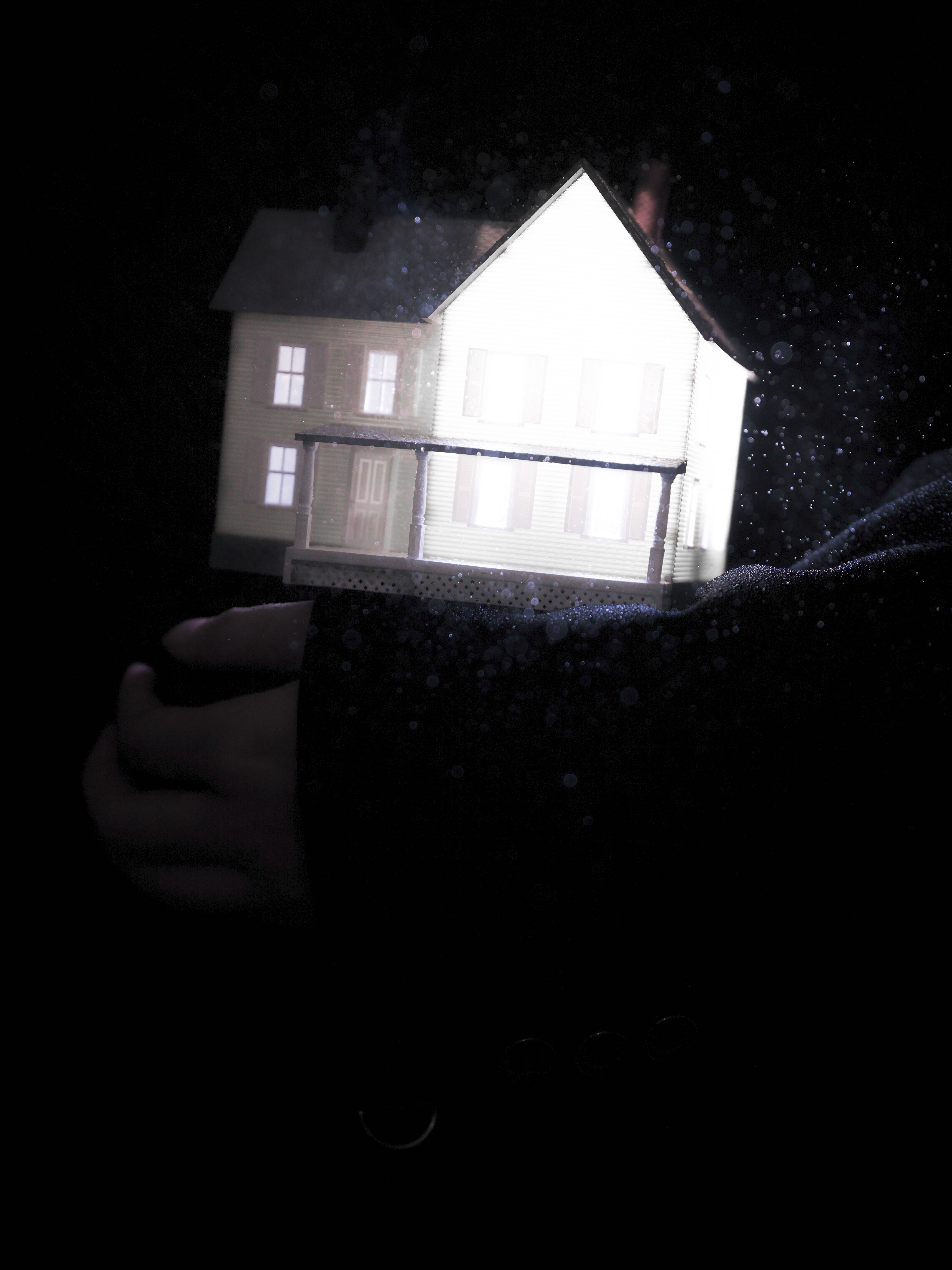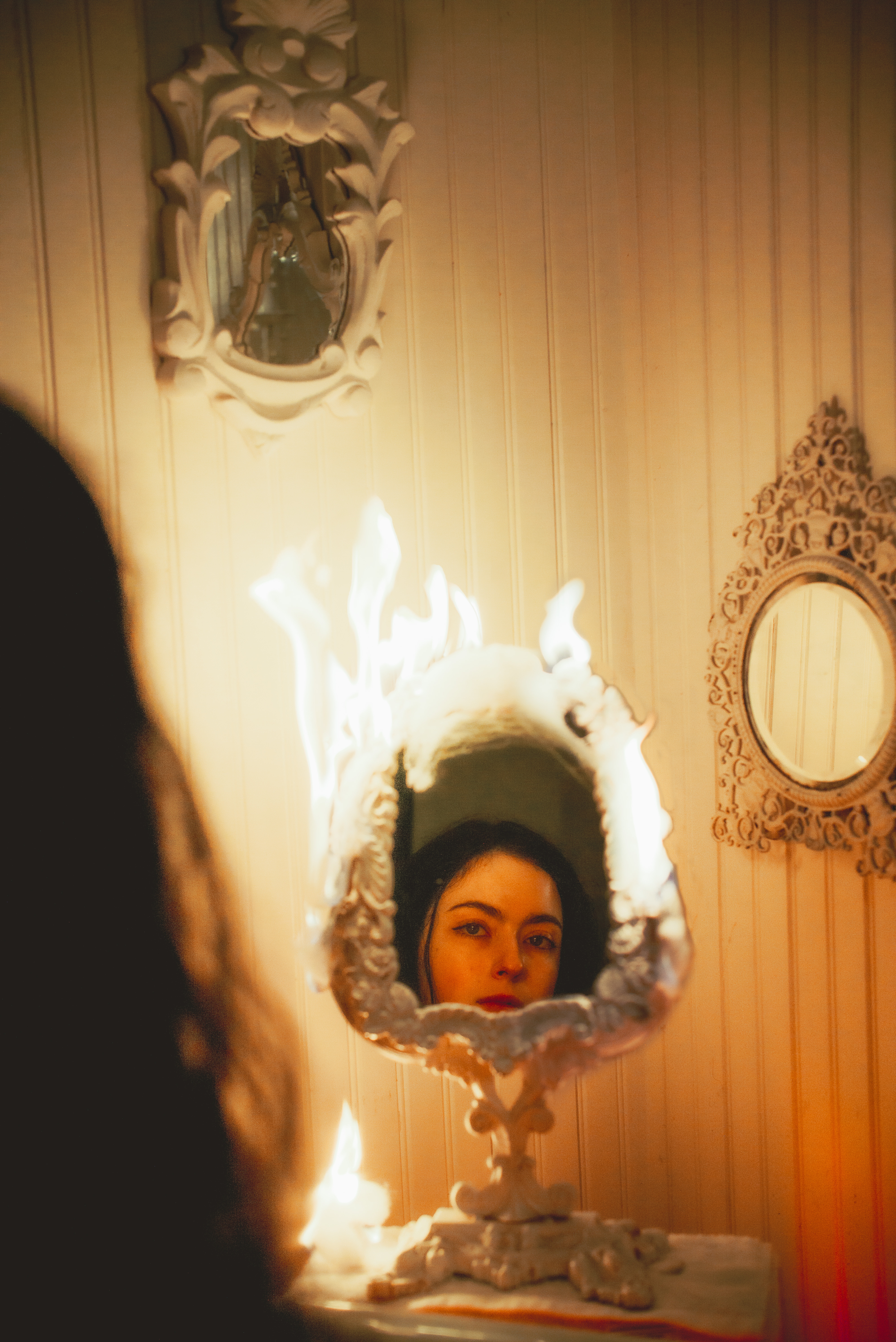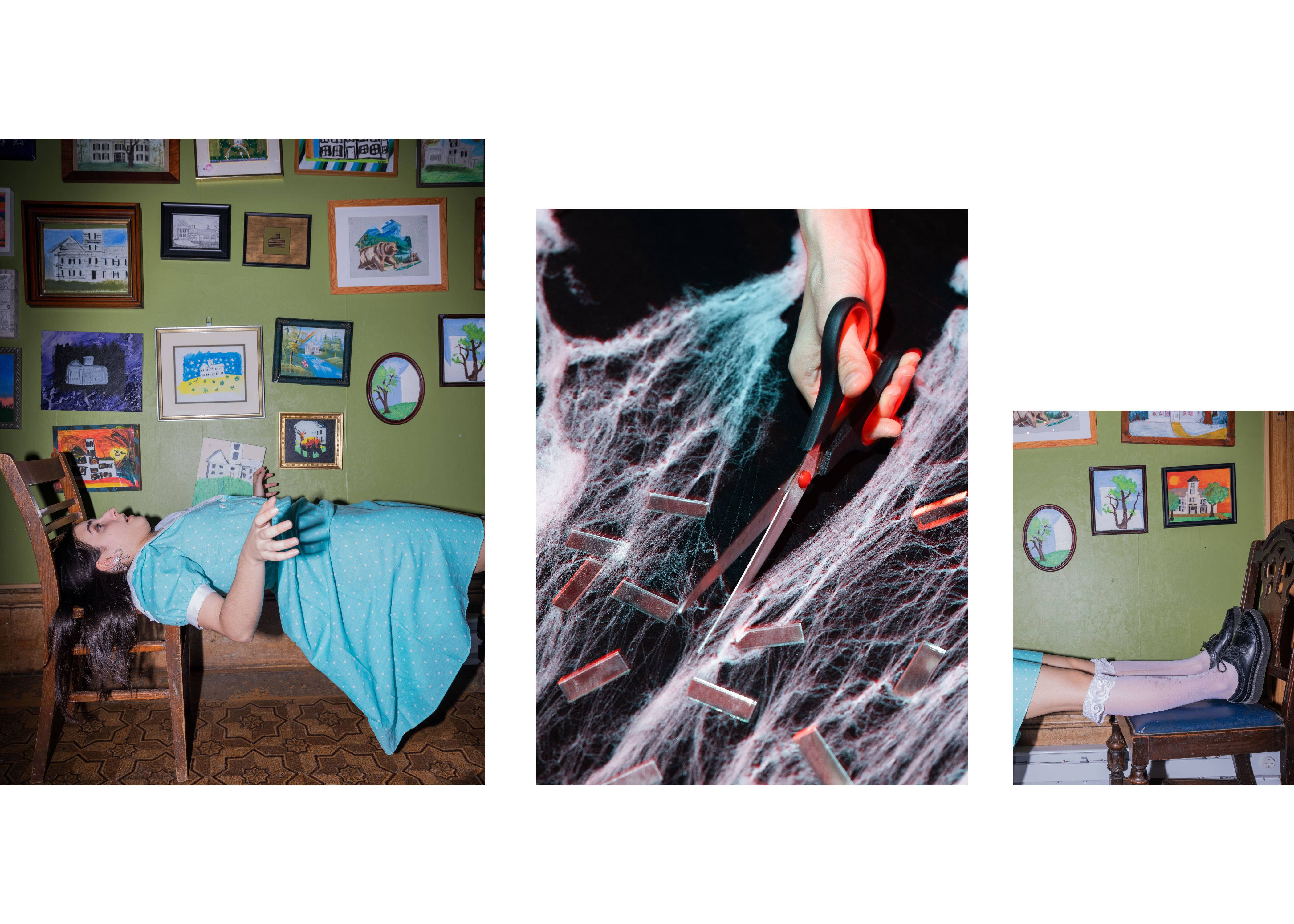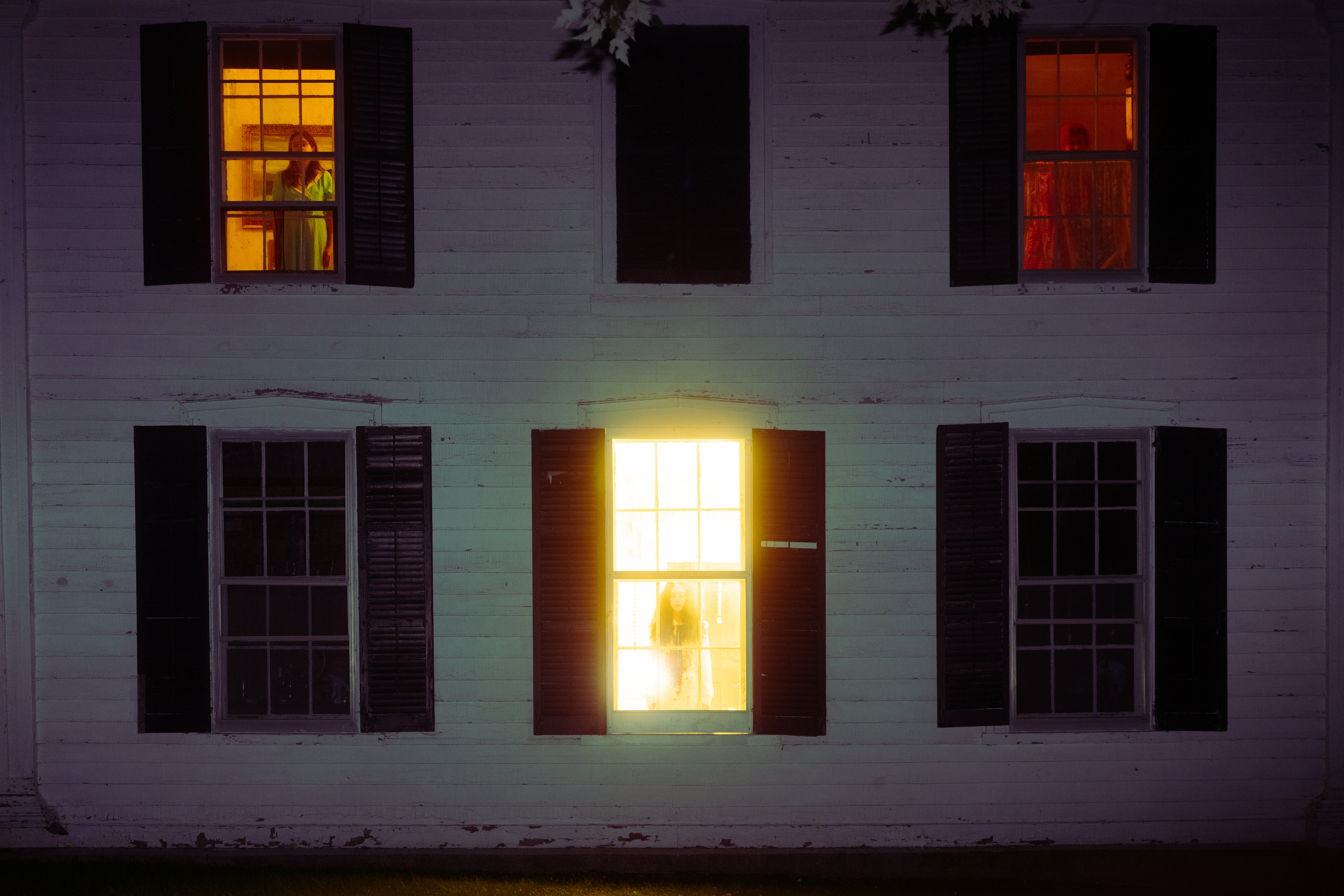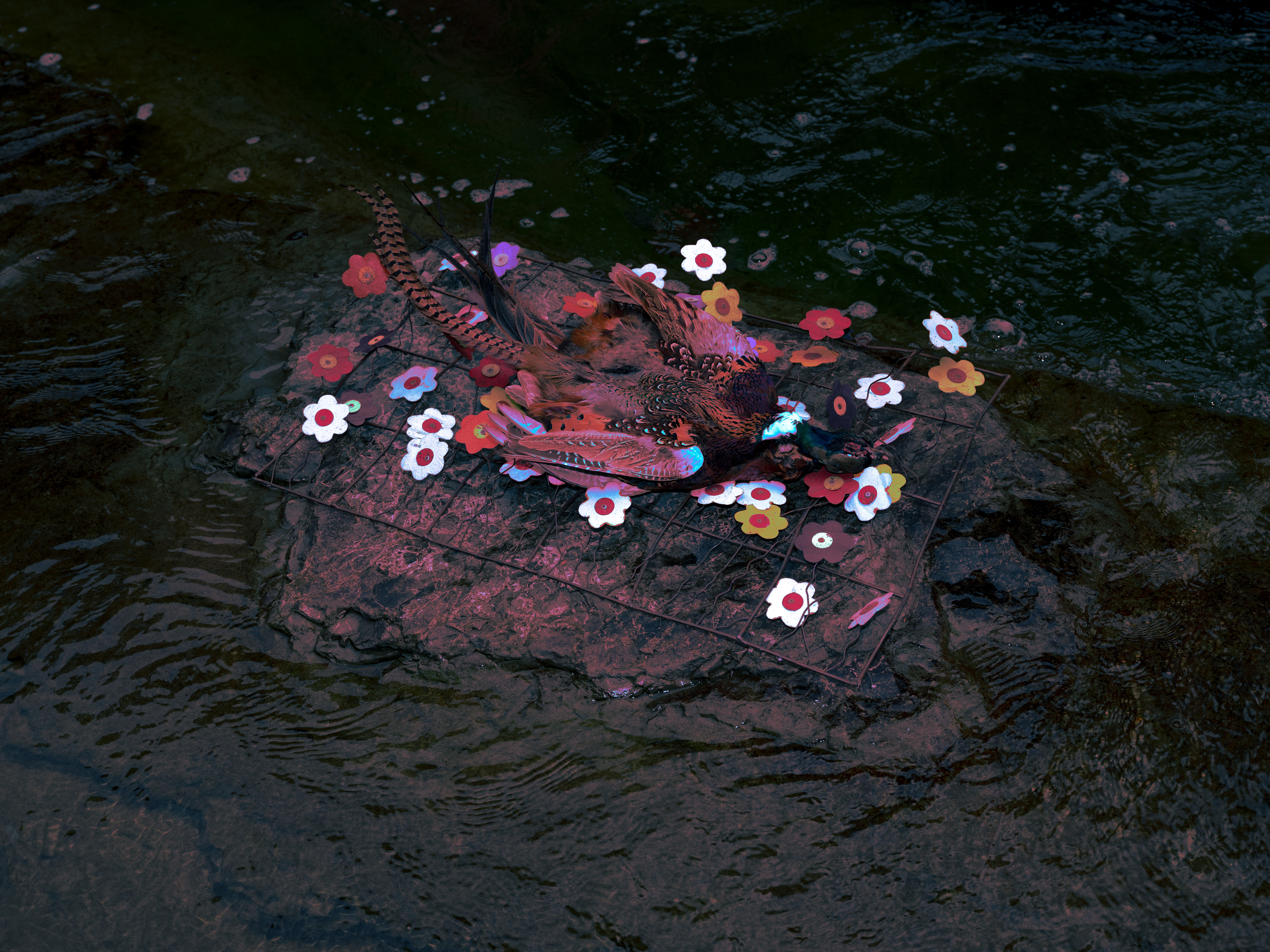白房子
| 2021 |
如今科学理性思维占领了不可置疑的高地,然而我们的现代大脑依然对巫术着迷。从日常大大小小的迷信 到社交论坛上的阴谋论,巫术依然以不同的载体贯穿西方社会。巫术往往以奇观的方式再呈现。科幻小说家 Arthur C. Clarke写道,“在任何一项足够先进的技术和魔法之间,我们无法做出区分。” 当代科技的确 给予人类在电子屏幕上一键生成一个平行世界、神一般的能力。 在摄影发展的初期它就以真相的守卫者姿态出现。但是当摄影在19世纪初期用来作为一种学习灵异现象 (灵魂质量、降神会)的客观工具后,该媒介就包含了和超自然现象的关系。除了它与生俱来的纪实性, 在当今我们仍然倾向于将摄影视为对窥见其他次元的置于坟墓之上的窗口。 唯灵论者相信逝去者不仅拥有和现世者沟通的能力也有想沟通的欲望。因为摄影在19世纪被唯灵论者作为 一种直接纪实灵异现象的手段,可以说唯灵论是最早的一种基于现代科技的宗教。摄影师Shannon Taggart 认为,唯灵论是历史上第一个不是用油画来表达精神肖像的宗教——而是用摄影。 而正因为早期 摄影普遍的中性真实性,唯灵论者的摄影被作为证实超自然现象的证据。 当代科技的进展如果极大地削减了摄影对真实的呈现,第一颗怀疑的种子早就在摄影发明的初期由唯灵论 者埋下了。19世纪末期,著名的灵异摄影师William H. Mumler 吸引了科学家、学者,以及各种的好奇的大众。随着美国内战的开始,Mumler在失去亲人的悲痛中看到了用摄影来安抚他们的机会。以现代的眼光 看来,Mumler在当时蹩脚的后期制作图像的技术并不能说服所有人,意料之中他最后因为行骗被送上的法庭。 在这之后的很多年里,不同程度教育背景的人都尝试着去揭开巫术现象和摄影之间的关系,用相机作为一 种理性作证的必备工具。我们可以看出唯灵论与摄影不仅以一种共生的状态形成互相造就彼此的对话,同时也不断揭露彼此。在一个充满了以摄影术为基础的假新闻时代,巫性思维再次回归,人们再一次需要找 到新的揭露巫术的方法。 经过严格地学术探究摄影与唯灵论之间的平行历史,我选择在『白房子』中用摄影叙事来描绘光怪陆离又 似曾相识的巫性世界。受漫画的视觉叙事和▸Dunae Michals的影响,我用电影置景以及打光的方式来尽可 能还原一个巫性思维的空间。我从1692年的塞勒姆女巫审判案以及其他的神秘主义题材历史中汲取素材, 演员会按照我事先写好的这个剧本在规定的空间中自由探索,我希望结果是一种介于纪实摄影和艺术摄影 还有沉浸式舞台之间的视觉奇观。我需要的是摆脱一种科学至上的正确,离开所谓的现实,回到想象构建 的巫性空间中。
Today scientific thinking may appear unassailable, yet magic remains surprisingly attractive to the modern mind. From the micro-superstitions that permeate our daily lives, to the fantastical tales of 4chan conspiracists, magic thrives in Western society.Magic trades in spectacle. As sci-fi author Arthur C. Clarke has written, “[a]ny sufficiently advanced technology is indistinguishable from magic." Indeed, modern technology bestows the user with formidable powers; godlike, we now conjure alternative worlds with the mere tap of an OLED display.Since its inception, photography has enjoyed a privileged relationship with the truth. But from capturing the souls of colonized subjects to the ectoplasmic séances of mid 19th Century spirit photography, the medium has maintained an equally close relationship with the supernatural. Despite its documentary credentials, even today it can be tempting to view photography as a window onto other dimensions. Dimensions that, as Barthes famously noted, are frequently located beyond the grave.Spiritualists maintain that the deceased have both the ability and the inclination to communicate with the living. Because photography served as the primary method of “documenting” 19th Century Spiritualist phenomena, it could be argued that Spiritualism constitutes the earliest example of a religious faith emerging from modern technology. As Shannon Taggart has observed, it was certainly the first to have produced its iconography not by means of painting, but photography. What’s more, widespread belief in the indexical nature of photography meant that Spiritualist images - rather than merely being seen as idealized artistic depictions - were treated by many as “documentary evidence” of paranormal activity.Nonetheless, if recent digital innovations have drastically undermined photography’s hold on truth, the first seeds of doubt were planted by Spiritualism itself only a few decades after the medium’s invention. In the late 19th century, the pioneering spirit photographs of William H. Mumler attracted the curiosity of scientists, scholars, and the general public alike. Following the American Civil War, Mumler saw great success in reuniting the bereaved with lost relatives by photographic means. Mumler’s claims that he could summon supra-normal apparitions in the form of silver halides did not convince everyone, however, and he was eventually taken to court for fraud and larceny.Yet advocacy of Spiritualism also came from more respected quarters. Most notably, science and mysticism met in the experiments of the esteemed British physicist and chemist, Sir William Crookes. Crookes invented the cathode-ray tube; a core component of both television and the X-ray. But he is also notorious for having attempted lens-based communion with the spirit world - with rather less spectacular results.Over the years, many other learned individuals championed the photo-occultist cause, employing that scientific apparatus par excellence, the camera, in the name of psychic research. As we’ve seen, though, in dialogue, spiritualism and photography not only symbiotically create each other, but also “expose” o ne another. At a time when photo-generated realities coincide with “fake news,” clearly magical thinking is once again ascendant. This calls for similar exposure.Revisiting the overlapping terrain between photography and Spiritualism, The White House reflects upon these issues by means of a sequential photographic narrative depicting esoteric rites. Inspired by the visual language of comics and the photographic storytelling of Duane Michals, I was interested to discover how our ingrained proclivity for magical thinking would manifest itself when transferred to the realm of staged photography. In practice, although the narrative follows a “script” based on research into the 1692 Salem witch trails, I encouraged the actors to freely explore this theme for themselves within the defined parameters. The goal; to create a parallel docu-fictional reality encouraging magical thinking.
| 2021 |
如今科学理性思维占领了不可置疑的高地,然而我们的现代大脑依然对巫术着迷。从日常大大小小的迷信 到社交论坛上的阴谋论,巫术依然以不同的载体贯穿西方社会。巫术往往以奇观的方式再呈现。科幻小说家 Arthur C. Clarke写道,“在任何一项足够先进的技术和魔法之间,我们无法做出区分。” 当代科技的确 给予人类在电子屏幕上一键生成一个平行世界、神一般的能力。 在摄影发展的初期它就以真相的守卫者姿态出现。但是当摄影在19世纪初期用来作为一种学习灵异现象 (灵魂质量、降神会)的客观工具后,该媒介就包含了和超自然现象的关系。除了它与生俱来的纪实性, 在当今我们仍然倾向于将摄影视为对窥见其他次元的置于坟墓之上的窗口。 唯灵论者相信逝去者不仅拥有和现世者沟通的能力也有想沟通的欲望。因为摄影在19世纪被唯灵论者作为 一种直接纪实灵异现象的手段,可以说唯灵论是最早的一种基于现代科技的宗教。摄影师Shannon Taggart 认为,唯灵论是历史上第一个不是用油画来表达精神肖像的宗教——而是用摄影。 而正因为早期 摄影普遍的中性真实性,唯灵论者的摄影被作为证实超自然现象的证据。 当代科技的进展如果极大地削减了摄影对真实的呈现,第一颗怀疑的种子早就在摄影发明的初期由唯灵论 者埋下了。19世纪末期,著名的灵异摄影师William H. Mumler 吸引了科学家、学者,以及各种的好奇的大众。随着美国内战的开始,Mumler在失去亲人的悲痛中看到了用摄影来安抚他们的机会。以现代的眼光 看来,Mumler在当时蹩脚的后期制作图像的技术并不能说服所有人,意料之中他最后因为行骗被送上的法庭。 在这之后的很多年里,不同程度教育背景的人都尝试着去揭开巫术现象和摄影之间的关系,用相机作为一 种理性作证的必备工具。我们可以看出唯灵论与摄影不仅以一种共生的状态形成互相造就彼此的对话,同时也不断揭露彼此。在一个充满了以摄影术为基础的假新闻时代,巫性思维再次回归,人们再一次需要找 到新的揭露巫术的方法。 经过严格地学术探究摄影与唯灵论之间的平行历史,我选择在『白房子』中用摄影叙事来描绘光怪陆离又 似曾相识的巫性世界。受漫画的视觉叙事和▸Dunae Michals的影响,我用电影置景以及打光的方式来尽可 能还原一个巫性思维的空间。我从1692年的塞勒姆女巫审判案以及其他的神秘主义题材历史中汲取素材, 演员会按照我事先写好的这个剧本在规定的空间中自由探索,我希望结果是一种介于纪实摄影和艺术摄影 还有沉浸式舞台之间的视觉奇观。我需要的是摆脱一种科学至上的正确,离开所谓的现实,回到想象构建 的巫性空间中。
Today scientific thinking may appear unassailable, yet magic remains surprisingly attractive to the modern mind. From the micro-superstitions that permeate our daily lives, to the fantastical tales of 4chan conspiracists, magic thrives in Western society.Magic trades in spectacle. As sci-fi author Arthur C. Clarke has written, “[a]ny sufficiently advanced technology is indistinguishable from magic." Indeed, modern technology bestows the user with formidable powers; godlike, we now conjure alternative worlds with the mere tap of an OLED display.Since its inception, photography has enjoyed a privileged relationship with the truth. But from capturing the souls of colonized subjects to the ectoplasmic séances of mid 19th Century spirit photography, the medium has maintained an equally close relationship with the supernatural. Despite its documentary credentials, even today it can be tempting to view photography as a window onto other dimensions. Dimensions that, as Barthes famously noted, are frequently located beyond the grave.Spiritualists maintain that the deceased have both the ability and the inclination to communicate with the living. Because photography served as the primary method of “documenting” 19th Century Spiritualist phenomena, it could be argued that Spiritualism constitutes the earliest example of a religious faith emerging from modern technology. As Shannon Taggart has observed, it was certainly the first to have produced its iconography not by means of painting, but photography. What’s more, widespread belief in the indexical nature of photography meant that Spiritualist images - rather than merely being seen as idealized artistic depictions - were treated by many as “documentary evidence” of paranormal activity.Nonetheless, if recent digital innovations have drastically undermined photography’s hold on truth, the first seeds of doubt were planted by Spiritualism itself only a few decades after the medium’s invention. In the late 19th century, the pioneering spirit photographs of William H. Mumler attracted the curiosity of scientists, scholars, and the general public alike. Following the American Civil War, Mumler saw great success in reuniting the bereaved with lost relatives by photographic means. Mumler’s claims that he could summon supra-normal apparitions in the form of silver halides did not convince everyone, however, and he was eventually taken to court for fraud and larceny.Yet advocacy of Spiritualism also came from more respected quarters. Most notably, science and mysticism met in the experiments of the esteemed British physicist and chemist, Sir William Crookes. Crookes invented the cathode-ray tube; a core component of both television and the X-ray. But he is also notorious for having attempted lens-based communion with the spirit world - with rather less spectacular results.Over the years, many other learned individuals championed the photo-occultist cause, employing that scientific apparatus par excellence, the camera, in the name of psychic research. As we’ve seen, though, in dialogue, spiritualism and photography not only symbiotically create each other, but also “expose” o ne another. At a time when photo-generated realities coincide with “fake news,” clearly magical thinking is once again ascendant. This calls for similar exposure.Revisiting the overlapping terrain between photography and Spiritualism, The White House reflects upon these issues by means of a sequential photographic narrative depicting esoteric rites. Inspired by the visual language of comics and the photographic storytelling of Duane Michals, I was interested to discover how our ingrained proclivity for magical thinking would manifest itself when transferred to the realm of staged photography. In practice, although the narrative follows a “script” based on research into the 1692 Salem witch trails, I encouraged the actors to freely explore this theme for themselves within the defined parameters. The goal; to create a parallel docu-fictional reality encouraging magical thinking.
